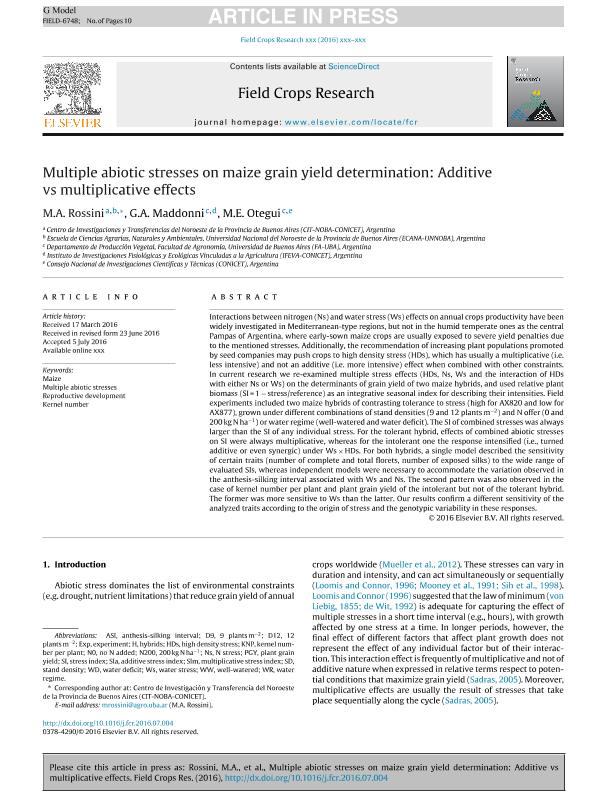Mostrar el registro sencillo del ítem
dc.contributor.author
Rossini, Maria de Los Angeles

dc.contributor.author
Maddonni, Gustavo Angel

dc.contributor.author
Otegui, Maria Elena

dc.date.available
2018-05-30T13:29:37Z
dc.date.issued
2016-11
dc.identifier.citation
Rossini, Maria de Los Angeles; Maddonni, Gustavo Angel; Otegui, Maria Elena; Multiple abiotic stresses on maize grain yield determination: Additive vs multiplicative effects; Elsevier Science; Field Crops Research; 198; 11-2016; 280-289
dc.identifier.issn
0378-4290
dc.identifier.uri
http://hdl.handle.net/11336/46577
dc.description.abstract
Interactions between nitrogen (Ns) and water stress (Ws) effects on annual crops productivity have been widely investigated in Mediterranean-type regions, but not in the humid temperate ones as the central Pampas of Argentina, where early-sown maize crops are usually exposed to severe yield penalties due to the mentioned stresses. Additionally, the recommendation of increasing plant populations promoted by seed companies may push crops to high density stress (HDs), which has usually a multiplicative (i.e. less intensive) and not an additive (i.e. more intensive) effect when combined with other constraints. In current research we re-examined multiple stress effects (HDs, Ns, Ws and the interaction of HDs with either Ns or Ws) on the determinants of grain yield of two maize hybrids, and used relative plant biomass (SI = 1 − stress/reference) as an integrative seasonal index for describing their intensities. Field experiments included two maize hybrids of contrasting tolerance to stress (high for AX820 and low for AX877), grown under different combinations of stand densities (9 and 12 plants m−2) and N offer (0 and 200 kg N ha−1) or water regime (well-watered and water deficit). The SI of combined stresses was always larger than the SI of any individual stress. For the tolerant hybrid, effects of combined abiotic stresses on SI were always multiplicative, whereas for the intolerant one the response intensified (i.e., turned additive or even synergic) under Ws × HDs. For both hybrids, a single model described the sensitivity of certain traits (number of complete and total florets, number of exposed silks) to the wide range of evaluated SIs, whereas independent models were necessary to accommodate the variation observed in the anthesis-silking interval associated with Ws and Ns. The second pattern was also observed in the case of kernel number per plant and plant grain yield of the intolerant but not of the tolerant hybrid. The former was more sensitive to Ws than the latter. Our results confirm a different sensitivity of the analyzed traits according to the origin of stress and the genotypic variability in these responses.
dc.format
application/pdf
dc.language.iso
eng
dc.publisher
Elsevier Science

dc.rights
info:eu-repo/semantics/openAccess
dc.rights.uri
https://creativecommons.org/licenses/by-nc-sa/2.5/ar/
dc.subject
KERNEL NUMBER
dc.subject
MAIZE
dc.subject
MULTIPLE ABIOTIC STRESSES
dc.subject
REPRODUCTIVE DEVELOPMENT
dc.subject.classification
Agricultura

dc.subject.classification
Agricultura, Silvicultura y Pesca

dc.subject.classification
CIENCIAS AGRÍCOLAS

dc.title
Multiple abiotic stresses on maize grain yield determination: Additive vs multiplicative effects
dc.type
info:eu-repo/semantics/article
dc.type
info:ar-repo/semantics/artículo
dc.type
info:eu-repo/semantics/publishedVersion
dc.date.updated
2018-05-29T18:35:49Z
dc.journal.volume
198
dc.journal.pagination
280-289
dc.journal.pais
Países Bajos

dc.journal.ciudad
Amsterdam
dc.description.fil
Fil: Rossini, Maria de Los Angeles. Consejo Nacional de Investigaciones Científicas y Técnicas. Centro de Investigaciones y Transferencia del Noroeste de la Provincia de Buenos Aires. Universidad Nacional del Noroeste de la Provincia de Buenos Aires. Centro de Investigaciones y Transferencia del Noroeste de la Provincia de Buenos Aires; Argentina
dc.description.fil
Fil: Maddonni, Gustavo Angel. Consejo Nacional de Investigaciones Científicas y Técnicas. Oficina de Coordinación Administrativa Parque Centenario. Instituto de Investigaciones Fisiológicas y Ecológicas Vinculadas a la Agricultura. Universidad de Buenos Aires. Facultad de Agronomía. Instituto de Investigaciones Fisiológicas y Ecológicas Vinculadas a la Agricultura; Argentina. Universidad de Buenos Aires. Facultad de Agronomía. Departamento de Producción Vegetal; Argentina
dc.description.fil
Fil: Otegui, Maria Elena. Consejo Nacional de Investigaciones Científicas y Técnicas; Argentina. Universidad de Buenos Aires. Facultad de Agronomía. Departamento de Producción Vegetal; Argentina
dc.journal.title
Field Crops Research

dc.relation.alternativeid
info:eu-repo/semantics/altIdentifier/doi/https://dx.doi.org/10.1016/j.fcr.2016.07.004
dc.relation.alternativeid
info:eu-repo/semantics/altIdentifier/url/https://www.sciencedirect.com/science/article/pii/S0378429016302143
Archivos asociados
